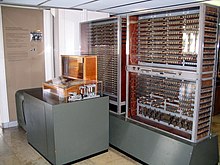Digital computer

Digital computers (English digit , number, from the Latin digitum , finger) are computers that perform their calculations on the basis of discrete number representations (mostly in binary form). Thus, all of the personal computers in use today are digital computers.
Today most digital computers work on an electronic basis. But others are also possible, for example on a mechanical, pneumatic and optical basis.
The term is often used to differentiate between analog computers that represent numbers analog (non-discrete). A calculated value is represented as electrical voltage or current and the calculation is carried out using suitable circuits. Therefore, analog computers are generally not programmable.
| Computer model | country | Installation | Floating point arithmetic |
Binary | Electronically | Programmable | Mighty Turing |
|---|---|---|---|---|---|---|---|
| Zuse Z3 | Germany | May 1941 | Yes | Yes | No | Yes, using punched tape | Yes, without any practical use |
| Atanasoff-Berry computer | United States | Summer 1941 | No | Yes | Yes | No | No |
| Colossus | UK | 1943 | No | Yes | Yes | Partly, by rewiring | No |
| Mark I. | United States | 1944 | No | No | No | Yes, using punched tape | Yes |
| Zuse Z4 | Germany | March 1945 | Yes | Yes | No | Yes, using punched tape | Yes, without any practical use |
| around 1950 | Yes | Yes | No | Yes, using punched tape | Yes | ||
| ENIAC | United States | 1946 | No | No | Yes | Partly, by rewiring | Yes |
| 1948 | No | No | Yes | Yes, using the resistor matrix | Yes |
Historical background
Finger arithmetic is the oldest calculation method. You can not only count with your fingers, you can also calculate. Very high numerical values can be displayed with the fingers and hands. The first digital calculator is the abacus, which comes in various forms: calculating table, calculating table, counting frame (spherical calculator), calculating cloth. Like finger counting, abacus counting has survived in certain areas to this day. The best-known ball calculators were the Chinese, Japanese and Russian abacus. Other digital computers are relay, tube and transistor computers, as well as mechanical calculating machines such as the Curta.